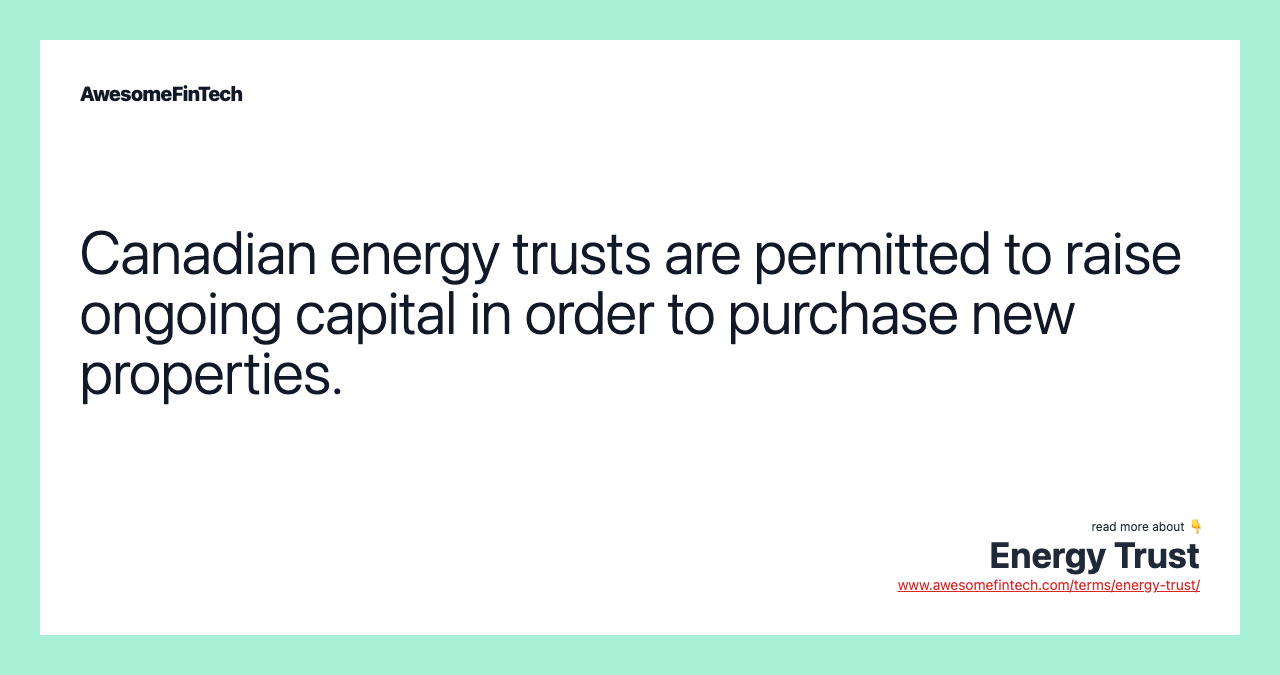Energy Trust
An energy trust is a type of investment vehicle that holds mineral rights for oil and gas wells, mines, and other natural resource properties. In the United States, energy trusts are only allowed to generate income from the mineral rights of existing properties; they are not allowed to acquire new properties, such as by buying additional wells. In the midst of this transition, shares in many Canadian energy trusts declined significantly, driven by fears that the more onerous tax burden would necessitate a decline in the energy trusts' dividend yields. A significant change in the energy trust market occurred in 2006 when the Canadian government announced plans to modify the tax treatment of Canadian energy trusts. In the United States, energy trusts are only allowed to generate income from the mineral rights of existing properties.

What Is an Energy Trust?
An energy trust is a type of investment vehicle that holds mineral rights for oil and gas wells, mines, and other natural resource properties. Energy trusts do not operate these properties themselves, instead, they rely on third-party companies to generate income from their assets.
Energy trusts are notable in that they are not required to pay corporate income taxes, provided that they payout at least 90% of their income to their shareholders. This income is then taxed at the level of the individual shareholders, bypassing the issue of double taxation.





Understanding Energy Trusts
Energy trusts are popular investment vehicles in the United States and Canada. However, there are some notable differences in how these vehicles are regulated in each country.
In the United States, energy trusts are only allowed to generate income from the mineral rights of existing properties; they are not allowed to acquire new properties, such as by buying additional wells. This means that U.S. energy trusts are required to draw down their existing income streams and eventually liquidate the trust once their mineral rights are fully depleted.
This makes it especially important for investors in U.S. energy trusts to understand the remaining reserves of the trust, as this will be critical in accurately estimating how long the trust will be able to continue making distributions to shareholders.
By contrast, Canadian energy trusts are permitted to raise ongoing capital in order to purchase new properties. This means that, in principle, a Canadian energy trust could continue paying distributions to shareholders indefinitely, provided it plans ahead to ensure an ongoing portfolio of mineral rights.
Assets Held by Energy Trusts
Energy trusts typically hold portfolios of mature properties that require relatively little ongoing capital expenditures. These properties should already have the infrastructure in place to extract the relevant resources, enabling the trust to pay large distributions without needing to reinvest significant capital into new infrastructure.
Example of an Energy Trust
A significant change in the energy trust market occurred in 2006 when the Canadian government announced plans to modify the tax treatment of Canadian energy trusts.
Previously, Canadian energy trusts were able to avoid corporate taxation altogether by passing through their distributions to shareholders, who were then taxed at the individual level. However, this resulted in a significant decline in government tax revenues, prompting the government to eliminate this favorable tax treatment by requiring energy trusts to pay taxes on their distributions as well.
This change effectively eliminated the relative tax efficiency of Canadian energy trusts as compared to corporations, prompting many trusts to convert themselves into corporations. In the midst of this transition, shares in many Canadian energy trusts declined significantly, driven by fears that the more onerous tax burden would necessitate a decline in the energy trusts' dividend yields.
Related terms:
Canadian Royalty Trust (CanRoy)
Canadian Royalty Trust– also called a CanRoy trust–is an oil, gas or mineral company that is organized as a trust rather than as a traditional corporation. read more
Capital Expenditure (CapEx)
Capital expenditures (CapEx) are funds used by a company to acquire or upgrade physical assets such as property, buildings, or equipment. read more
Corporate Tax
A corporate tax is tax on the profits of a corporation that generate revenue for a government. read more
Dividend Yield
The dividend yield is a financial ratio that shows how much a company pays out in dividends each year relative to its stock price. read more
Double Taxation
Double taxation refers to income taxes paid twice on the same income source. It occurs when income is taxed at both the corporate and personal level, or by two nations. read more
Infrastructure Trust
An infrastructure trust is a type of income trust that finances, constructs, owns, operates, and maintains different infrastructure projects in a given region. read more
Investment Vehicle Defined
Investment vehicles are securities or financial asset, such as equities or fixed income instruments, that an individual uses to gain positive returns. read more
Liquidation
Liquidation is the process of bringing a business to an end and distributing its assets to claimants, which occurs when a company becomes insolvent. read more
Mineral Rights
Mineral rights are the ownership rights to underground resources such as oil, silver, or natural gas. read more
Master Limited Partnership (MLP)
A master limited partnership (MLP) is a publicly traded limited partnership that combines the tax benefits of a partnership with the liquidity of a public company. read more